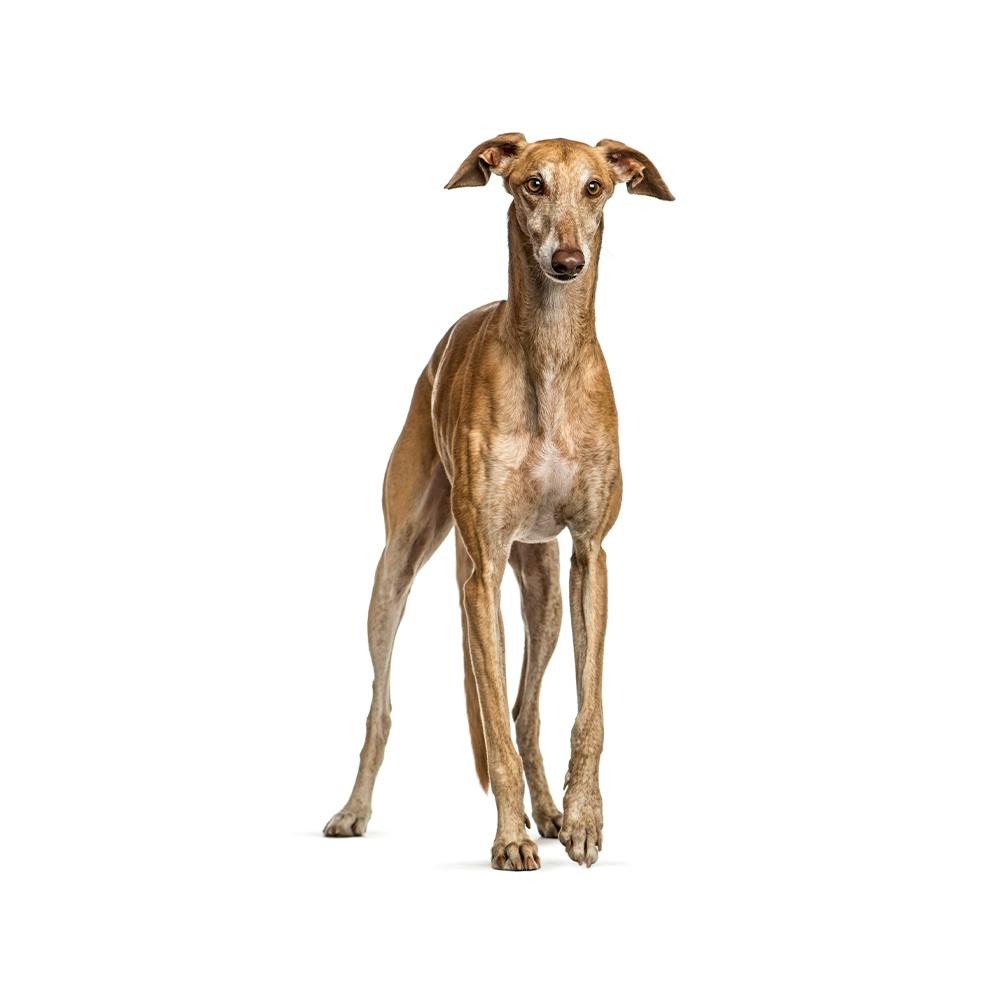
Greyhound
The Greyhound is an ancient breed that can be traced back over 4,000 years to early civilizations like the Egyptians and the Greeks. Historically, they were bred for hunting, specifically for coursing and chasing game. Greyhounds were highly prized and often associated with nobility and royalty in various cultures. They have been used for racing and continue to be popular in the world of professional racing.
- Origin
- Egypt
- Alternate Names
- English Greyhound, Gentleman's Greyhound
- Life Expectancy
- 10-13 years
- Average Male Height
- 28-30 inches
- Average Female Height
- 27-28 inches
- Average Male Weight
- 65-70 pounds
- Average Female Weight
- 60-65 pounds
- Coat Length
- Short
- Coat Type
- Smooth
- Coat Colors
- Black, Black & White, Black Brindle & White, Blue Fawn, Blue, Blue & White, Blue Brindle, Fawn, Fawn & White, Liver, Liver & White, Red, Red & White, Red Brindle, Red Brindle & White, White, White & Black, White & Fawn, White & Liver, White & Red, Blue Brindle & White, Blue Fawn & White, Black Brindle, White & Blue, White & Black Brindle, Liver Brindle, White & Blue Brindle, White & Blue Fawn, White & Liver Brindle, White & Red Brindle
- Coat Pattern
- Ticked, Black Mask, Parti-Color, Solid
Genetic Predispositions and Health
Greyhounds can suffer from many health conditions, including anesthetic metabolism (CYP2B11), arteriosclerosis (renal), atopic dermatitis, avulsion of tibial tuberosity, babesiosis susceptibility, bald thigh syndrome, brachygnathism, cataracts, cruciate ligament disease, cryptorchidism, cutaneous and renal glomerular vasculopathy, cutaneous asthenia, deafness, dystocia, epilepsy, exocrine pancreatic insufficiency, Factor VIII deficiency (hemophilia A), follicular dysplasia, glomerulonephritis, Greyhound alopecia, hemangiosarcoma, hip dysplasia, hyperhomocysteinemia, hyperkalemia during anesthesia, hypertension, hypothyroidism, inflammatory bowel disease (IBD), intervertebral disk disease, keratoma (digital corns), primary lens luxation, lumbosacral stenosis, lupoid onychopathy, lymphoma, malignant hyperthermia, megaesophagus, meningoencephalitis, metatarsal fistula, heart conditions such as mitral valve disease, nasal parakeratosis, optic nerve hypoplasia and micropapilla, osteochondritis dissecans (shoulder), osteochondritis dissecans (stifle), osteosarcoma, pannus, patellar luxation, peripheral neuropathy (Greyhound), persistent right aortic arch, polydontia, polydontia (supernumerary teeth), polyneuropathy, postoperative hemorrhage, retinal degeneration, sesamoid disease, Startle disease, Vasculitis, vitreous degeneration, and von Willebrand disease. As a deep chested breed Greyhounds can suffer from bloat, also known as gastric dilation volvulus (GDV). This is a life-threatening condition that can come on suddenly, so it’s important to know the warning signs and get an affected dog immediate veterinary care. As a sighthound, they can be sensitive to anesthesia so this should always be discussed with a veterinarian.
Personality and Behavior
Greyhounds are known for their gentle, calm, and affectionate demeanor. Despite their reputation as racing dogs, they are couch potatoes at heart and love to lounge around the house. They are generally good with children and can coexist peacefully with other dogs, especially if socialized from an early age. Due to their strong prey drive, it's essential to keep them on a leash or in a securely fenced area when outside, as they instinctively chase after small animals. Greyhounds have a short and smooth coat that lies close to their skin. They have little body fat and are not well-suited to cold weather, so they may need a coat or sweater in colder climates.
Fun Facts
They are the fastest breed of Greyhounds are one of the fastest dog breeds, capable of reaching speeds up to 45 miles per hour (72 km/h).
Despite their athleticism and speed, Greyhounds are often referred to as "45-mph couch potatoes" due to their love of lounging and relaxing indoors.
In ancient civilizations, Greyhounds were sometimes buried with their owners, indicating their high status and significance in those societies.
Greyhounds have a unique and aerodynamic build, featuring a deep chest, long legs, and a slim, sleek body. Their "inverted" shape has been the inspiration for artists, poets, and kings for many thousands of years.
References
https://www.akc.org/dog-breeds/greyhound/
https://www.hillspet.com/dog-care/dog-breeds/greyhound
https://www.fci.be/en/nomenclature/GREYHOUND-158.html
https://www.ukcdogs.com/greyhound
https://vgl.ucdavis.edu/panel/italian-greyhound-health-panel